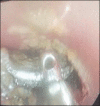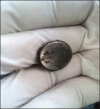Endoscopic removal of impacted oesophageal foreign body: A case report and a review of literature
- PMID: 27251523
- PMCID: PMC4955460
- DOI: 10.4103/0189-6725.181706
Endoscopic removal of impacted oesophageal foreign body: A case report and a review of literature
Abstract
Foreign body (FB) impaction in the oesophagus is fairly common in paediatric Gastroenterology practice. This study aims to describe a case of an unusually impacted button lithium battery, in the mid-oesophagus of a 7-year-old child that was confirmed, and removed during oesophagogastroduodenoscopy. A 7-year-old male child, presented at the Emergency Paediatric Unit of our hospital with a history of ingestion of a button-like metallic object. A plain soft tissue X-ray of the neck and chest, however, revealed a dense round object located at the sternal angle of Louis. The object was dislodged and identified as a flat lithium battery after an oesophagogastroduodenoscopy, carried out under general anaesthesia using a flexible forward-viewing video gastroscope. The button battery was subsequently passed in faeces. Endoscopic removal of impacted oesophageal FBs under general anaesthesia is an effective and safe procedure in children in experienced hands.
Figures
References
-
- Michaud L, Bellaïche M, Olives JP. Groupe Francophone d’Hépatologie Gastroentérologie et Nutrition Pédiatriques (GFHGNP). Ingestion of foreign bodies in children. Recommendations of the French-speaking Group of Pediatric Hepatology, Gastroenterology and Nutrition. Arch Pediatr. 2009;16:54–61. - PubMed
-
- Higo R, Matsumoto Y, Ichimura K, Kaga K. Foreign bodies in the aerodigestive tract in pediatric patients. Auris Nasus Larynx. 2003;30:397–401. - PubMed
-
- Litovitz T, Schmitz BF. Ingestion of cylindrical and button batteries: An analysis of 2382 cases. Pediatrics. 1992;89(4 Pt 2):747–57. - PubMed
Publication types
MeSH terms
LinkOut - more resources
Full Text Sources
Other Literature Sources
Medical




